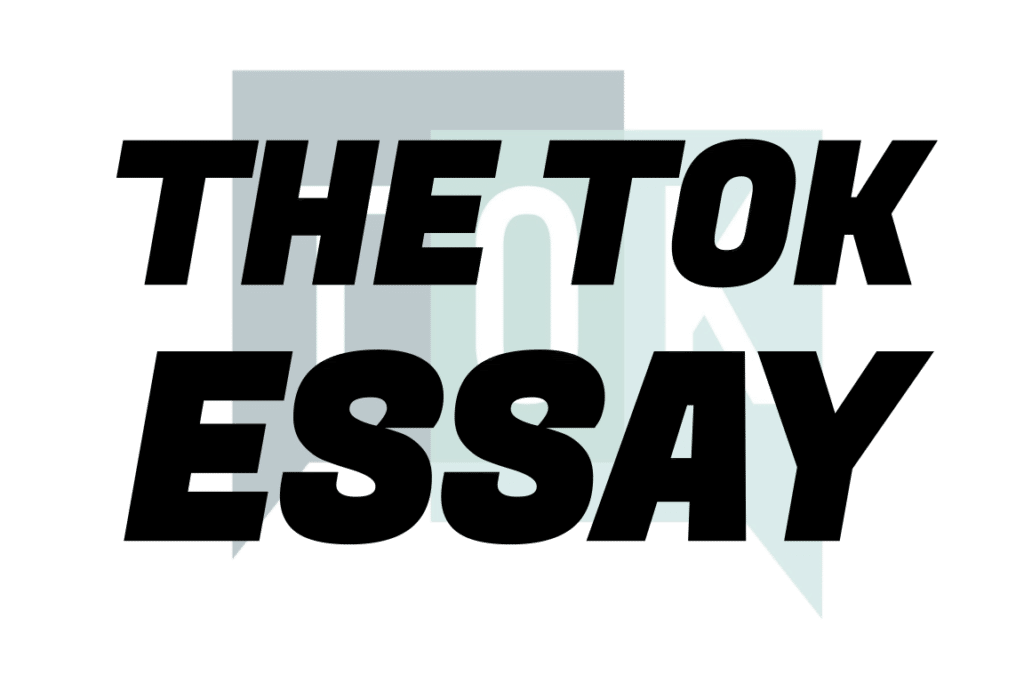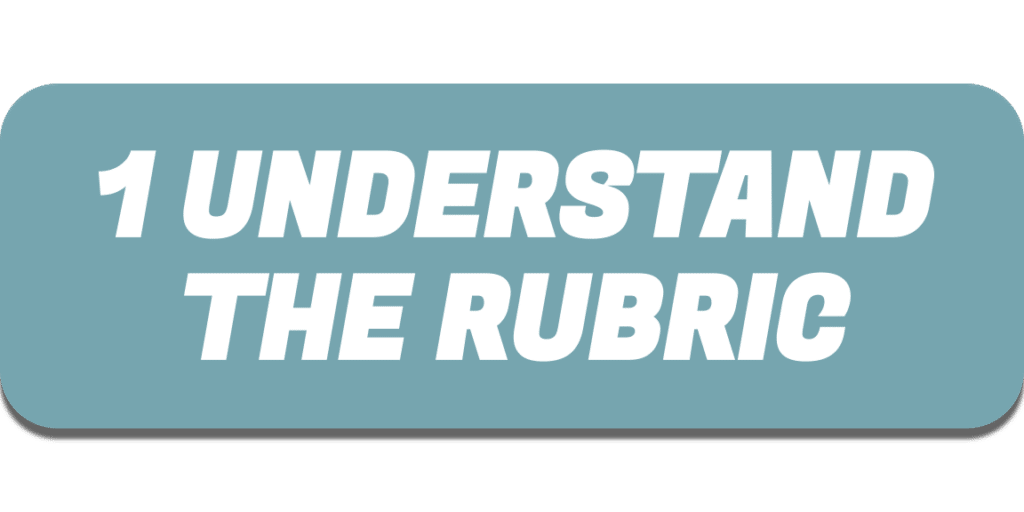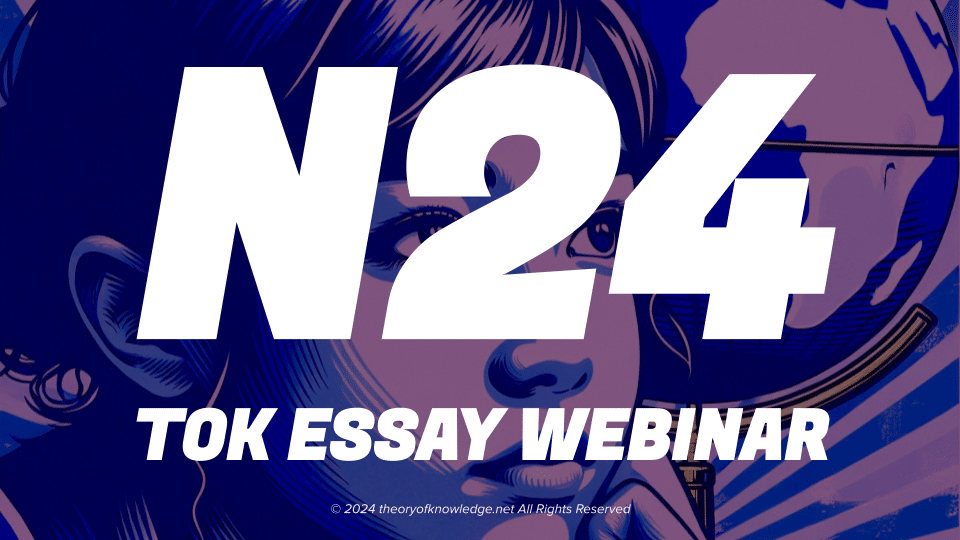

IB TOK Essay examples
Type a search phrase to find the most relevant TOK Essay examples for you
Not sure what to search for? You can always look through our example Theory of Knowledge coursework below for inspiration.

All TOK Essay Examples
Filter exemplars, do we need custodians of knowledge discuss with reference to two areas of knowledge., how can we reconcile the opposing demands for specialization and generalization in the production of knowledge discuss with reference to mathematics and one other area of knowledge., want to get full marks for your tok essay allow us to review it for you 🎯, do we need custodians of knowledge discuss with reference to two areas of knowledge, nothing is more exciting than fresh ideas, so why are areas of knowledge often so slow to adopt them discuss with reference to the human sciences and one other area of knowledge., fast track your coursework with mark schemes moderated by ib examiners. upgrade now 🚀, are we too quick to assume that the most recent evidence is inevitably the strongest discuss with reference to the natural sciences and one other area of knowledge., is subjectivity overly celebrated in the arts but unfairly condemned in history discuss with reference to the arts and history, is replicability necessary in the production of knowledge discuss with reference to two areas of knowledge., are visual representations always helpful in the communication of knowledge discuss with reference to the human sciences and mathematics., for artists and natural scientists, which is more important: what can be explained or what cannot be explained discuss with reference to the arts and the natural sciences., does it matter if our acquisition of knowledge happens in "bubbles" where some information and voices are excluded discuss with reference to two areas of knowledge., to what extent is the knowledge we produce determined by the methodologies we use discuss with reference to history and one area of knowledge., tok essay: 5. “how can we distinguish between good and bad interpretations discuss with reference to the arts and one other area of knowledge”, tok essay 2021 title 3: “labels are a necessity in the organization of knowledge, but they also constrain our understanding.” discuss this statement with reference to two areas of knowledge., tok essay - “the quality of knowledge is best measured by how many people accept it.” discuss this claim with reference to two areas of knowledge., nothing is more exciting than fresh ideas, so why are areas of knowledge often so slow to adopt them, is subjectivity overly celebrated in the arts but unfairly condemned in history discuss with reference to the arts and history., is subjectivity overly celebrated in the arts but unfairly condemned in history, do we underestimate the challenges of taking knowledge out of its original context and transferring it to a different context discuss with reference to two areas of knowledge..
How to Write a Good TOK Essay - A 10-Step Guide for IB Students
This post will walk you through how to write a good TOK essay.

Look. While reading your TOK essay, the examiner will ask themselves questions such as:
- Does this essay show a clear understanding of knowledge questions?
- Have you supported your claims and counter claims with relevant, insightful examples?
- How effectively does the essay explore multiple perspectives on knowledge?
- Is there a logical flow that connects each argument to the next?
- Does the essay demonstrate personal engagement and critical reflection?
- Are the Areas of Knowledge (AOK) and Ways of Knowing (WOK) thoughtfully integrated?
Therefore, keeping these questions in mind as you write will guide you to writing a well-rounded TOK essay that meets IB requirements and engages the reader.
And, each step in this guide will help you tackle these crucial elements and more to ensure your TOK essay stands out as a thoughtful and organized piece of work.
Let’s dive right in.
Step 1: Understand the Core Purpose of the TOK Essay
The TOK essay encourages students to reflect on the nature of knowledge rather than simply demonstrate factual understanding.
So, you must understand what the IB program expects — an essay that critically examines “knowledge questions” (KQs) related to different ways of knowing (WOK) and areas of knowledge (AOK).
Think of the essay as an exploration of how humans know what they know.
For example, in the natural sciences, “knowledge” is often based on evidence and the scientific method, whereas in the arts, it might rely more on subjective interpretation and emotion.
When you understand such nuances, you’ll approach your essay with a thoughtful and analytical mindset.
Step 2: Analyze the Prescribed Titles
Each year, the IB provides a list of prescribed titles.
Each title usually presents a unique way to examine knowledge. Some focus on specific AOKs (such as history or ethics). In contrast, others might challenge you to reflect on WOKs like language, reason, or emotion.
When choosing a title, pick one that resonates with you or piques your curiosity.
For example, if you’re interested in how culture influences perception, choose a title that allows you to discuss cultural biases in knowledge formation.
In addition, spend some time brainstorming different ideas for each title to find the one that offers a solid foundation for developing arguments and counter arguments.
Step 3: Craft a Relevant Knowledge Question (KQ)

Your Knowledge Question (KQ) is the foundation of your essay. It sets the stage for the arguments you’ll develop.
A strong KQ emerges from your chosen title and invites deeper exploration rather than a simple answer.
So, when developing your KQ, ensure it’s open-ended, encourages multiple perspectives, and stays relevant to your title.
For example, if the title centers on ethics, your KQ could be, “To what extent do cultural norms influence ethical judgments?” This question isn’t looking for a single solution but rather invites a balanced exploration of how ethics varies across societies and periods.
Another example might be, “How do scientific advancements challenge traditional ethical beliefs?”
This clear, relevant KQ will guide your essay, helping you construct a cohesive argument that remains focused on the title.
It will also ensure you engage with the TOK’s central goals, allowing you to demonstrate your understanding of how knowledge functions and evolves.
Step 4: Organize Your TOK Essay with a Clear Outline
The outline for your TOK essay provides structure and ensures your arguments flow logically from one point to the next.
Hence, start with a three-part structure: introduction, body, and conclusion, each serving a distinct purpose.
- Introduction: Introduce your chosen KQ and briefly explain why it is important. Then, hint at the perspectives you’ll explore, but keep it concise. An effective introduction engages the reader immediately and keeps them interested in reading your essay.
- Body paragraphs: Each paragraph should present one main idea, starting with a claim and then a counter claim. Use specific examples to support each perspective and transition smoothly between arguments to maintain a logical flow.
For example, if you’re discussing ethical knowledge, your first paragraph might discuss a claim about how ethics are universal, while the next presents a counterclaim on moral relativism.
Furthermore, using phrases like “on the other hand” or “in contrast” helps connect your ideas.
- Conclusion: Conclude by summarizing the insights you gained from examining the KQ. Reflect on what this exploration has taught you about the nature of knowledge, and consider any implications or lingering questions.
Step 5: Build Strong Arguments with Claims and Counterclaims

Let’s say your essay focuses on the reliability of historical knowledge.
A claim might state that primary sources provide direct insight into historical events, lending reliability to historical knowledge.
On the other hand, a counterclaim might discuss how primary sources can be biased, as they often reflect the perspectives of those who recorded the events.
Balancing each claim with a counterclaim adds complexity to your argument and demonstrates a nuanced understanding of your KQ.
In addition, this back-and-forth approach enriches your essay, allowing you to explore the complexities of knowledge.
Step 6: Use Specific Examples to Support Your Claims
Examples are the backbone of any TOK essay.
They make your abstract points concrete and show you can connect theory to real-world applications.
Thus, aim for examples from various fields—science, history, personal experiences, or cultural practices.
For instance, if your KQ involves the role of memory in knowledge, you might use the example of eyewitness testimony to demonstrate memory’s fallibility, especially under stress.
Alternatively, if you’re discussing the role of cultural perspectives in knowledge, an example could be how historical accounts of colonization differ significantly depending on the cultural lens through which they are told.
Link each example back to your KQ to reinforce your arguments and keep your essay focused.
Step 7: Integrate Reflection and Personal Insight
A TOK essay is unique because it invites your personal views. Hence, reflecting on your experiences or beliefs can add depth to your analysis.
For instance, if your KQ involves cultural influence on knowledge, you could share a personal experience of learning about a different culture that challenged your assumptions.
This type of reflection makes your essay more authentic and shows how the knowledge question has real-world implications.
Tip : Your insights should be subtle, relevant, and not dominate the essay. The idea is to establish a stronger connection with the reader and make your arguments more compelling.
Step 8: Write with Clarity and Precision

Avoid unnecessary words and stick to a language that conveys your ideas easily. Remember, TOK essays have a strict word limit, so make every word count.
For instance, instead of writing, “It could potentially be suggested that cultural factors sometimes shape historical knowledge,” you could simplify this to, “Historical knowledge is often shaped by cultural factors.”
This streamlined style ensures that your points are easy to follow, allowing the examiner to focus on your argument without getting bogged down in convoluted language.
Step 9: Review and Edit Thoroughly
After you’ve finished your first draft, take a step back before revising.
This break will help you return with fresh eyes, making it easier to spot any areas that need improvement.
Review your essay carefully, checking that each argument is clear, logical, and well-supported by examples.
Reading your essay aloud is a great way to catch awkward phrasing and identify areas that could be rephrased for clarity.
Step 10: Use Coursework Grading Tools, AI, and a Plagiarism Checker
Before submitting your essay, take advantage of resources that can help refine it.
For instance, Revision Dojo’s coursework grading tool and AI-powered plagiarism checker can analyze your essay for structure, clarity, and originality.
The grading tool gives feedback on the organization and flow of your arguments, while the plagiarism checker ensures that your work is original and meets IB’s standards of academic integrity.
Furthermore, the tools can help identify last-minute improvements, giving you confidence that your essay is well-structured and polished for submission.
Final Thoughts
There you have it - that’s how to write a good TOK essay.
Following these ten steps, you can craft a well-organized, thoughtful TOK essay that engages with complex knowledge questions.
From selecting a title and creating a solid outline to using resources like Revision Dojo tools, each stage brings you closer to an essay that shows critical thinking
Speaking of Revision Dojo, you can join the platform free using the link below.
Join the Dojo
Ace your exams with RevisionDojo
- Thousands of practice questions
- Study notes and flashcards for every topic and subject
- Free Jojo AI tutor

RevisionDojo, saved my exams. I went from a 4 to a 6 in math, a 5 to a 7 in econ and a 5 to a 7 in chem. ”
Joseph Chan
IBDP student
Rated Excellent
On Trustpilot
Planning and structuring the TOK essay
TOK Home > Free TOK notes > TOK essay guidance > Planning and structuring the TOK essay

Once you’ve grasped the essay rubric , and chosen your title , you can start planning and structuring your TOK essay. You base this around the 3 interactions with your teacher, which are one-on-one meetings discussing your progress, and receiving feedback.
As well as the interactions, you can also ask your teacher specific questions about your essay, for example, the suitability of arguments and examples.
STEP 3: Plan and structure your TOK essay
Interaction 1.
In your first interaction, you’ll discuss the title that you have chosen and why, your interpretation of its general meaning, and the key words from the title that you’ve identified and will be focusing on.
You should also have a good idea about the areas of knowledge you’ll be using as the context of your essay (these may be specified in the title), the key concepts that could be included, and have a rough idea about the arguments and counterarguments that could be offered.
By the end of the first interaction, you should be clear about your choice (ideally, the meeting will have confirmed you made the right decision, rather than making you rethink it, but that’s still not a problem at this early stage of the essay-writing process), know the context you’ll be using, and be ready to write your introduction.

Interaction 2
During your second interaction, you’ll explain how you have moved your ideas forward, and the arguments and counterarguments that you’re developing. Ideally, you should be able to show your teacher your introduction, and a rough plan of the rest of your essay.
Be ready to discuss personal experiences and real-world examples that you will use to support points, key thinkers, and different points of view. It’s also useful to discuss any challenges and problems that you’ve encountered. Your teacher should then give you plenty of advice on how to turn all of this into a draft essay, which takes you to the final interaction.
Interaction 3
The third interaction is arguably the most important one, as it is when you will discuss your draft essay, and receive written feedback on how to turn this into your final version.
The first thing to ensure is that your draft is as complete as it possibly can be. The reason for this is that your teacher can only give you one set of written feedback, so if you’ve given them something that doesn’t have much detail, they won’t be able to give you any meaningful advice.
Make sure your teacher has had enough time to go over your essay, and has provided you with clear and detailed feedback on the strength and clarity of your arguments, the suitability of your examples, how successfully you’ve considered perspectives and implications, and how effectively your essay answers the questions. You should now feel ready to write the final version of the essay.
A four-step guide to the TOK essay
Click on the buttons below to take you to the four steps of creating a great TOK essay. Don’t forget that we have plenty of videos on this and other aspects of the course, and members of the site have access to a huge amount of other resources to help you master the course and assessment tasks.

Check out our three-minute explainer video on the TOK essay here . The video goes over the basics of the TOK essay, such as how it’s assessed, the word count and other practical details, terms such as ‘perspectives’ and ‘implications’, and the role of real-world examples in justifying claims and arguments.
You’ll find more videos on this and other aspects of TOK here , and you can dive into much more depth via our free and premium webinars, here .
Watch our essay & exhibition webinars
Click on the images below to access these premium webinars on how to create the essay and exhibition. Access more webinars here , and watch our videos on the assessment tasks on this page .

FAQs about the TOK essay
How do i choose my tok essay title.
You choose your essay from six prescribed essay titles, that are released at the beginning of your second DP year. We give a few tips on how to choose a PT that will work for you here . But briefly, choose one that links to your pre-existing knowledge, and that you find personally engaging.
What will I be writing about in my TOK essay?
You’ll be answering your prescribed title, within the context of two areas of knowledge, considering how different perspectives might affect our response to the question, and what the implications of your arguments are.
Can I use ChatGPT to write my essay?
You can use ChatGPT to help you gather materials for your essay, but you should definitely not be using it to write the essay. Be very careful with ChatGPT. It bases its answers on online material, and much of this is inaccurate or out-of-date. For example, depending on what you ask it, it may tell you that you have to explore multiple areas of knowledge (rather than the two stipulated by the titles), and that you have to identify a separate knowledge question to the title (which is absolutely not the case).
How much help should I expect from my teacher?
Your teacher should run through the PTs when they are first released, and then meet you for three interactions, during which you’ll discuss your progress. They are allowed to give you one set of written feedback. But you can consult them at other times with specific questions.
Do I need to use real-world examples in my TOK essay?
Yes, real-life examples help illustrate your points and make your arguments more tangible. They can be drawn from personal experiences, historical events, scientific discoveries, etc.
Should I include my personal opinion in the TOK essay?
While the TOK essay is not about your personal opinion per se, it’s important to reflect on your perspective and how it shapes the way you understand the title. However, you should avoid using the essay as a platform for rants or unsubstantiated claims.
Is it necessary to include counter-arguments in my TOK essay?
Yes, including counter-arguments shows a deeper understanding of the complexity of the topic and demonstrates your critical thinking skills. It also enables you to consider different perspectives, and evaluate the implications of arguments.
Should I include the 12 key concepts in my essay?
Yes, as much as you can, draw on the key concepts such as justification, evidence, perspective, bias, certainty, and objectivity within your arguments linking them to the title, and to the real-world examples you draw on.
How do I ensure that my TOK essay reflects my own original thinking, and avoids plagiarism?
Clearly attribute ideas and sources that are not your own, and strive to present original insights and interpretations supported by evidence and reasoning. See our point above on using ChatGPT – never view this as more than a tool to help you gather material for your essay, rather than a tool to write it for you.
What are some common pitfalls to avoid when writing a TOK essay?
Avoid oversimplifying complex issues, relying solely on personal opinion without justification, neglecting counter-arguments, veering off the question, and failing to include a consideration of different perspectives.
How long do I have to write my essay?
You’ll have 6 months from the time the prescribed titles are released, to the deadline date for uploading your essay to the IB. However, most schools will set their own deadline for completing the essay, so that everyone has plenty of time to complete your PPF, and upload it on time. Follow what your school tells you about this.
How important is the TOK essay PPF?
The PPF (‘Planning and Progress Form’) is the document that you fill in to outline your discussions during the three essay. Although this is not directly assessed, it is an important part of demonstrating that you have approached the TOK essay in an ethical way, which is now particularly important in the era of ChatGPT.
What are some effective strategies for revising and editing my TOK essay to improve clarity and coherence?
Take breaks between revisions, seek feedback from peers or teachers, and carefully proofread for grammar, punctuation, and coherence.
Should I include references or a bibliography in my TOK essay?
While not required, referencing sources appropriately adds credibility to your essay; use footnotes or endnotes for citations.

Subscribe to the free TOK newsletter!
Subscribe to our free newsletter, and collect fantastic examples that will help you to understand the key ideas of TOK, support your essay and exhibition discussions, and help you to become an authentic critical thinker .
You’ll encounter some of the most important thinkers from the past and the present, go beyond the headlines of contemporary events and issues around the globe, and see how TOK concepts manifest in the real-world. Subscribe HERE !

IMAGES